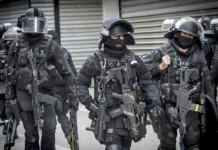In a video I posted up yesterday from Josh and Henry’s 9-Hole channel, the pair took the MK12 in a classic configuration to the range on a speed run of their practical accuracy course.
These runs are to showcase what a well put together system can accomplish under time pressure and how the whole kit put together can aid, or hinder, a shooter engaging at various ranges. It can also assist in showing the practical limits of system and shooter based upon putting all the factors into place and under time.
Can a 5.56 rifle realistically make hits at 1100 yards? Yes. Stephanie here recently did so. But it isn’t an easy or fast thing to accomplish, the legs on a 5.56 are pretty tired by 700 and you’re stumbling across the finish line by 1100.
Given the need to rapidly engage, what are the hard limits of a rifle/optic combination and what are the factors that most positively influence that combination. I know people who have connected to a target at 700 and 800 yards with a red dot, but in what are the equivalent of laboratory conditions where they slowly tweaked things until they got it right. Guess a hold, hit or miss, adjust.
The MK12 with a far more modernized optic than the MK4 Leupolds give the shooter more information more quickly in order to accomplish their tasks faster and more efficiently. The other major change the was removing the suppressor. Based upon the course of fire’s requirements, namely the required rate of fire, the environmental effects caused by the silencer to the optic had them omit the silencer for the run.
Net detractive effect, groups were going to open up a little. Josh & Henry know this and have tested this. Net gain, no miraging at the muzzle for the longer shots as the can got hot. The overall effect was that for the trade up in signature at the shooting point, the rapidity of effect on target was tremendous.
This goes back to knowing the shot process and choosing the gear that is going to best improve your ability to efficiently move through the steps of the shot process. The shooter assess the effects and make the determination to shoot again or transition as the steps in the course were cleared, or under more serious circumstance transition from most immediate threats to least immediate in order.
Picking you optic, and the rifle it sits upon, is about knowing your most likely required shot processes and building out capability from most likely to least likely. This is why red dots and SFP LPVOs are the most useful for most users, they’re addressing close rapid shots as their most likely necessity. We can make rifles today that cover down on a lot of asked for capability really well, but firearms continue to be specialists. There will always be caliber/firearm combos that do the one task really well but are limited to that role while others do many things fairly well and usually in an effective enough manner that it meets or exceeds the bare minimum performance.
There is another point of context, are you optimizing (the specialist role) or are you meeting or exceeding multiple requirements? Rifle trials and gear selection are almost universally built around the meet or exceed format. They have a minimum and a goal for performance in category after category so the system will do all of the items asked. Military requests get extremely detailed in this regard. Police requests can too. They usually need everything spelled out so that in the event of a failure of some manner it can be addressed that a capability was specified and a correction can be made or liability can be leveled as the case may warrant.
Anyway, a good showcase of capability upgrades we’ve managed through the GWOT era.



